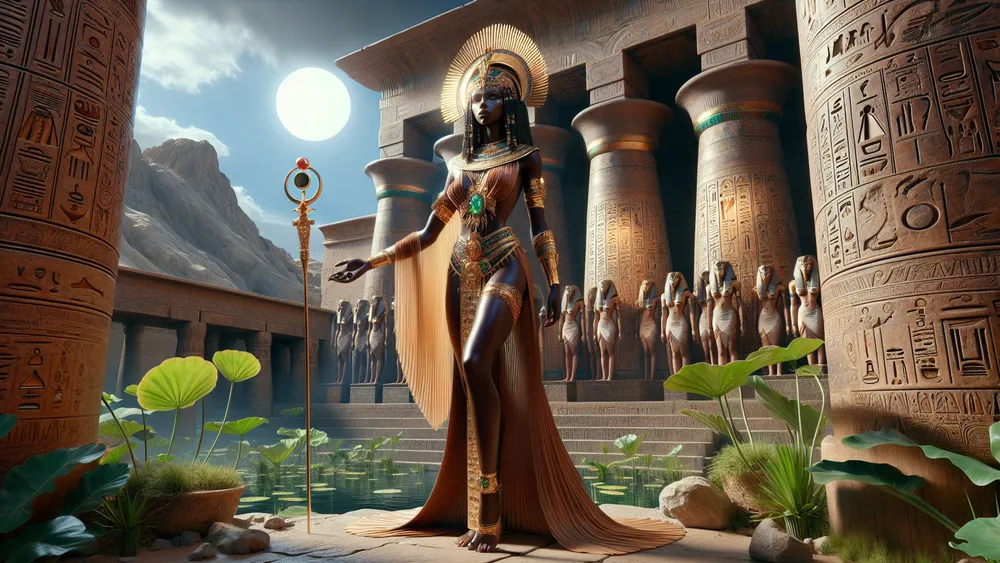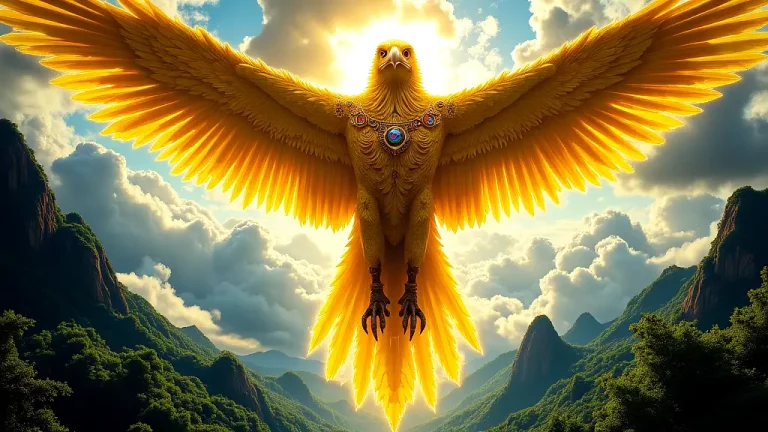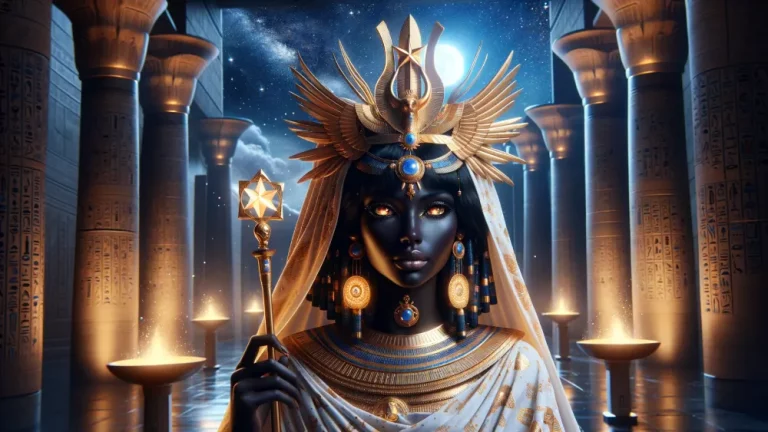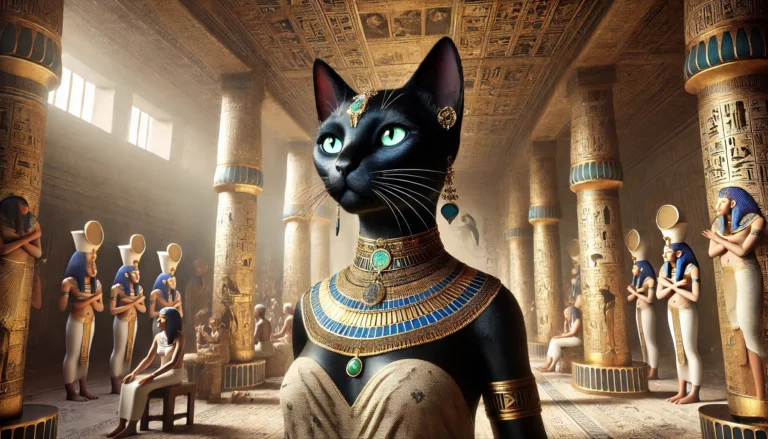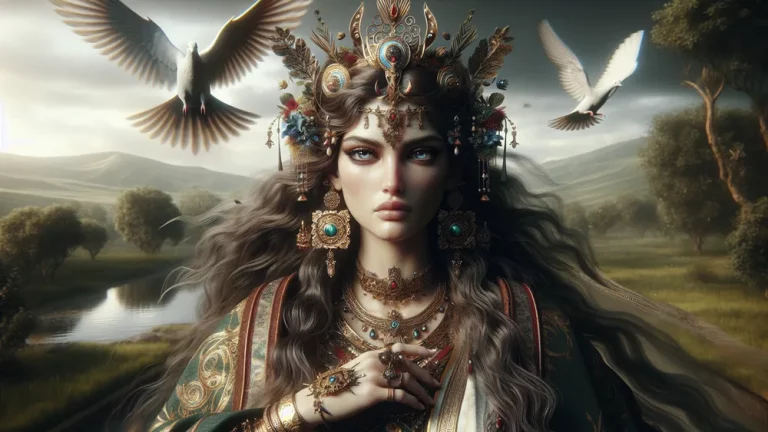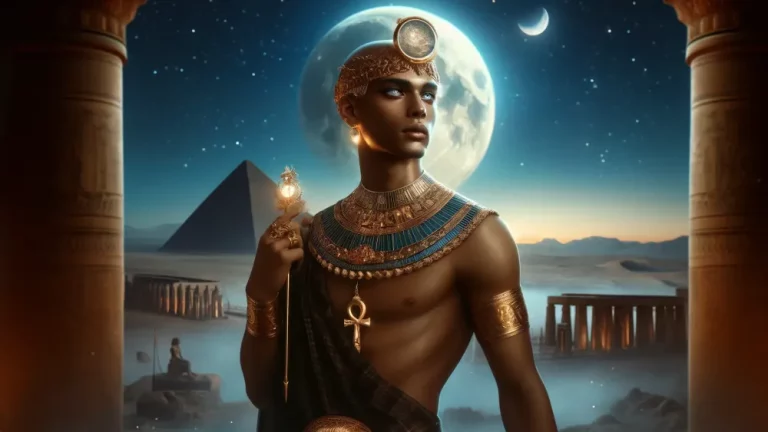Iusaaset: Ancient Egyptian Goddess Of Creation
Thinking about old Egyptian tales, names like Ra, Osiris, and Isis might pop up in your head. But, the list of Egyptian gods is big and detailed, each god or goddess has a specific spot in the world’s setup. For example, Iusaaset, known as the “Grandmother of the Gods”, stands out.
Key Points:
- Iusaaset is an ancient Egyptian goddess known as the Grandmother of the Gods.
- She is closely linked to creation myths and the Tree of Life.
- Iusaaset is shown in art as a woman with a solar disk, horns, a scepter, and an ankh.
- She is connected to Atum and Ra, playing a key role in stories about beginnings.
- Worship of Iusaaset involved offerings, festivals, and rituals in temples.
- Iusaaset’s influence can be seen in later cultures and modern media.
This blog will step into the stories and legends of Iusaaset, checking out where she came from, how she looks in art designs and symbols, how she links to other gods, and her big part in stories about how things began. We will also see how people honored her in old times, her effect on later cultures, and how she shows up in today’s books and shows.
Whether you love mythology or you’re just starting to learn about it, this detailed guide will give you a better grasp of Iusaaset and her spot in the old Egyptian beliefs system.
Iusaaset: Overview and Key Facts
| Key Point | Description |
|---|---|
| Name | Iusaaset (also spelled Iusaas, Jusas, or Iusaset) |
| Title | “Grandmother of the Gods” |
| Role in Mythology | Very old goddess tied to making things and the Tree of Life |
| Earliest Mentions | Shows up in old Pyramid and Coffin Texts |
| Depiction in Art | She is shown as a woman with a solar disk and horns, who holds a scepter and ankh |
| Symbols | Scepter, ankh, solar disk, horns, and the Tree of Life |
| Major Connections | She is linked to Atum (he is either her shadow or counterpart) and Ra |
| Significance in Creation | Seen as a key force in stories about beginnings, often as a mother figure |
| Worship Practices | Temples for her, giving offerings, and rituals to honor her place in making things start |
| Influence on Later Cultures | Has an effect on later stories and religions, with similar gods appearing in many places |
| Modern Representation | Appears in books, movies, and media, showing a renewed interest in Egyptian tales |
Knowing About Iusaaset
To see how important Iusaaset is in old Egyptian tales, it’s important to look at her beginnings, looks, and ties with other gods and goddesses. So, here are the details of where she started and why she is important in history.
Beginnings and Importance in History
The earliest talks about Iusaaset are seen in the Pyramid and Coffin Texts. They come from the Old Kingdom times in ancient Egypt. These writings say she is a very old goddess, often called the “shadow” or counterpart of Atum, the creator god. In stories about how things began, she has a big part as a mother figure, showing ideas of making and birth. Think of her like a start in a book, setting things up for what comes next. She is important in religion there, she’s linked to the Tree of Life, which is a sign of growth and food. To sum up her importance:
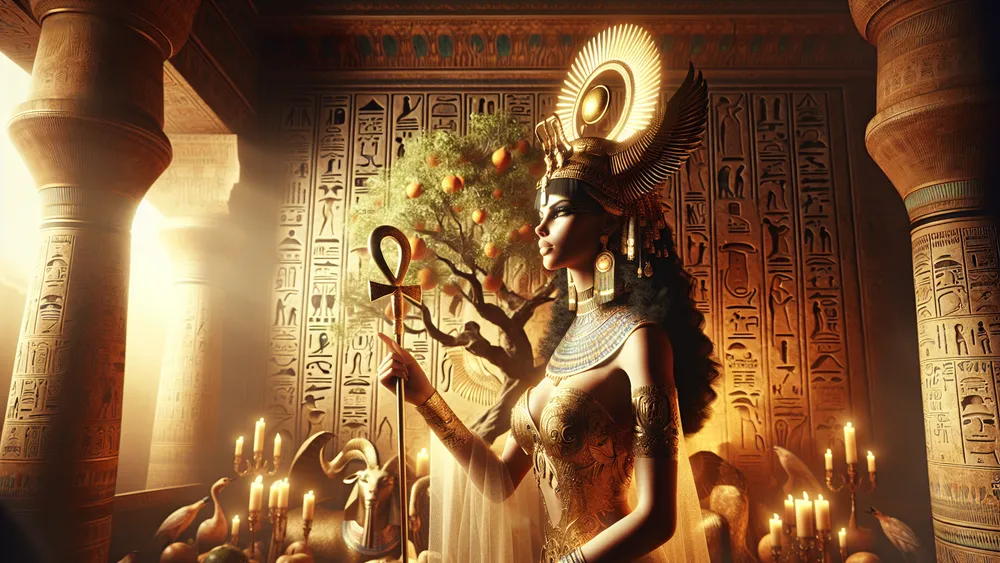
- Very Old Goddess: Seen as one of the earliest gods and goddesses in Egyptian tales.
- Creation Role: Has a big part in beginning stories, often tied to Atum.
- Mother Figure: Shows making, birth, and the caring part of the world.
Therefore, by knowing these things, you can see why Iusaaset was respected and how she fit into the bigger picture of old Egyptian tales.
Iusaaset was a highly respected goddess in ancient Egyptian tales, known for her ancient origins, role in creation stories, and motherly attributes.
How She’s Shown and Her Symbols
In old Egyptian art and writings, they show Iusaaset as a royal woman wearing a sun disk and cow horns on her head, meaning she is holy and tied to the sun god Ra. Also, she holds a scepter, which shows power, and an ankh, the sign of life. Not just for show, these things tell what she does and why she’s important. Think of these signs like modern symbols, such as a crown for kings or a heart for love. To see more about her looks, here are her important symbols:
- Scepter: Means power and high status among gods.
- Ankh: Means life, showing her part in making and feeding life.
- Sun Disk and Horns: Connect her to the sun god Ra, showing her holy side.
- Tree of Life: Tied to her, meaning growth, making things, and feeding.
So, by knowing these symbols, it really helps you see how people saw Iusaaset and why they respected her in old Egyptian times.
Connections with Other Gods
Iusaaset is closely linked to other big Egyptian gods, especially Atum and Ra. In the Heliopolitan creation story, they call her the shadow or partner of Atum, the god who made himself from the first waters of Nun. Think of Iusaaset as a helper in making everything, as Atum does the creating and Iusaaset is the mother who supports and keeps everything going.
This pair shows her importance in the group of gods, as she works with Atum to make the world. Moreover, her link with Ra is clear because of the sun disk and cow horns she wears, meaning she’s connected to the sun god and her part in the life and rebirth cycle.
To see how Iusaaset fits with other creation gods, let’s compare what she does with Atum and Ra. This will show how these gods, while different, have shared ideas and signs that point to their parts in making and keeping the world.
| Attribute | Iusaaset | Atum | Ra |
|---|---|---|---|
| Role | Very old goddess of making | Maker god, made himself | Sun god, life and rebirth god |
| Symbols | Scepter, ankh, sun disk, horns | Flat top hill, sun disk | Sun disk, falcon, sun boat |
| Connection | Shadow/partner of Atum | Made himself, father of gods | Sun itself, life cycle |
| Depiction | Woman with sun disk and horns | Man with two crowns | Falcon-headed man with sun disk |
Therefore, by looking at these links and signs, you can better understand how Iusaaset fits into the bigger picture of Egyptian stories and her key part in making and looking after everything.
Iusaaset’s Part in Creation Stories
To really get Iusaaset’s importance, you need to look at her part in the old Egypt creation myths. So, here, we dig into the exact stories and signs that show her effect in these creation stories.
The Heliopolitan Creation Story
In the Heliopolitan story about creation, Iusaaset has a key part as the shadow or partner of Atum, the god who made himself and came out of the first waters of Nun.
It is interesting to think of Iusaaset as the helping partner in big creation work, where Atum does the creating, and Iusaaset is the caring, mother part that keeps this creation going. This pair is important, because it shows her value in the group of gods.
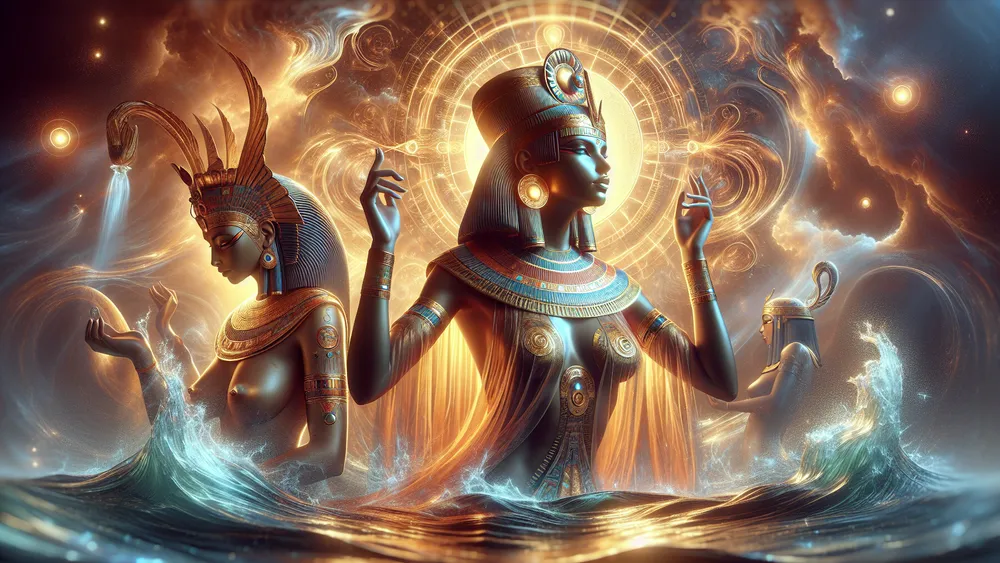
Iusaaset is also often seen as the oldest mother of all gods, a name that shows her effect on the godly family and the making of the world. Think of her as the main mother in a family tree, whose being there and help are needed for the ongoing growth of the family.
This view not only raises her level but also shows her key part in the universal order.
The Tree of Life Connection
The Tree of Life has deep importance in Egyptian stories, meaning creation, growth, and support. It is interesting to think of the Tree of Life as a big family tree or as a source of food and life that supports everyone. Iusaaset is closely linked to this strong sign, often shown in or near the Tree of Life.
This link shows her part in the ongoing cycle of making and renewal. A tree gives fruit and shade. So, Iusaaset’s being there makes sure the ongoing life and support of the world. Her link with the Tree of Life shows her big part in caring for and keeping the balance of the world, making her important in the story of making and growing.
The Tree of Life in Egyptian stories symbolizes creation, growth, and support, with Iusaaset’s connection to it emphasizing her vital role in maintaining balance and supporting life.
Worship and Cult of Iusaaset
Now that we’ve looked at what Iusaaset did in stories about creation, we now look into how people praised her and the ways people praised her in early Egypt.
Temples and Worshiping Ways
Temples for Iusaaset were mainly in the old city of Heliopolis, which was a big place of religion in old Egypt. It is interesting to know that these temples were not just places for praising but also where people learned and did cultural things. Ways of doing things connected to her praise were detailed and full of meaning. For example, giving food, drink, and valuable items was done to show respect and ask for her good things. Having festivals for Iusaaset often had walking together in lines, singing hymns, and saying prayers, similar to today’s religious events. Here are some important parts of how she was praised:
- Offerings: Things like bread, beer, and incense were often given.
- Festivals: Special days set aside to show respect for Iusaaset with public parties.
- Rituals: Priests did daily actions that had prayers and reading of special texts.
These ways show the respect old Egyptians had for Iusaaset and show how important she was in their religion.
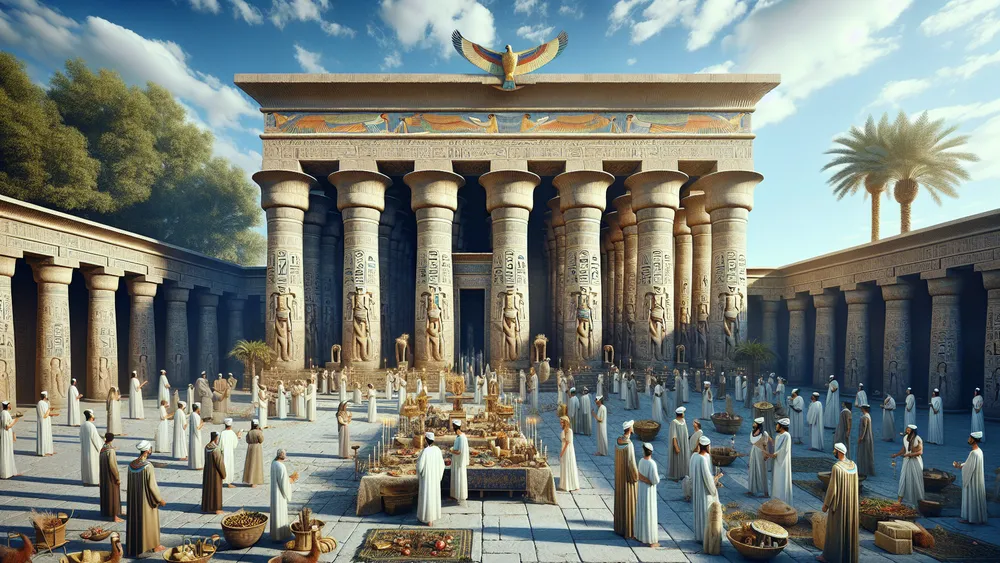
Impact on Later Cultures
People continued to feel the effect of praising Iusaaset in later cultures and religions because her traits and jobs were often included into other belief systems. It is interesting to see that the idea of an ancient mother god, like Iusaaset, pops up in many stories around the world.
For example, the Greek god Gaia, she is also seen as the mother of all gods and the Earth, sharing Iusaaset’s caring and making parts. In the same way, in Hindu stories, the god Prithvi, who represents the Earth and is respected as a mother figure. These similarities show that the respect for a mother-creator figure crossed cultural edges, affecting many religious traditions.
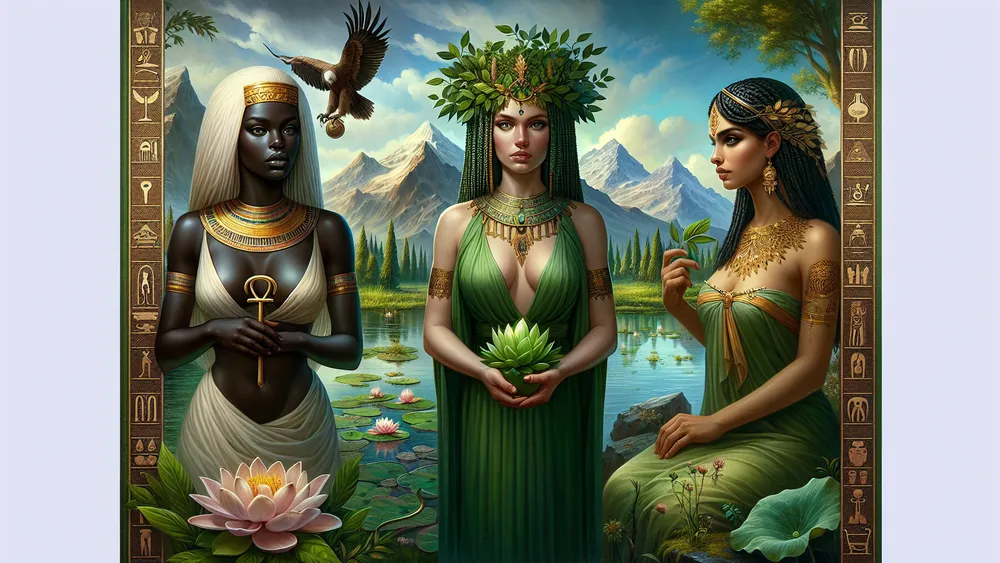
This cultural crossover shows the common human habit to show making and supporting as a caring god.
Iusaaset in Modern Culture
After looking at how Iusaaset affected later groups, we can now look into how she is shown in today’s books, TV shows, and current studies.
How She Appears in Literature and Media
In today’s books and TV shows, Iusaaset often shows up as a sign of creation and ancient power. You may have seen her in books that look into old Egyptian stories, like Rick Riordan’s “The Kane Chronicles,” where Egyptian gods play a big part. TV and movies, such as “Stargate SG-1,” also mention Egyptian gods, helping with a new interest in these old myths.
This comeback is like the liking of superhero movies, where old ideas are redone for today’s people. Interest in ancient Egypt, driven by findings and shows, has put gods like Iusaaset in front of people again, letting younger people explore and like these rich old stories.
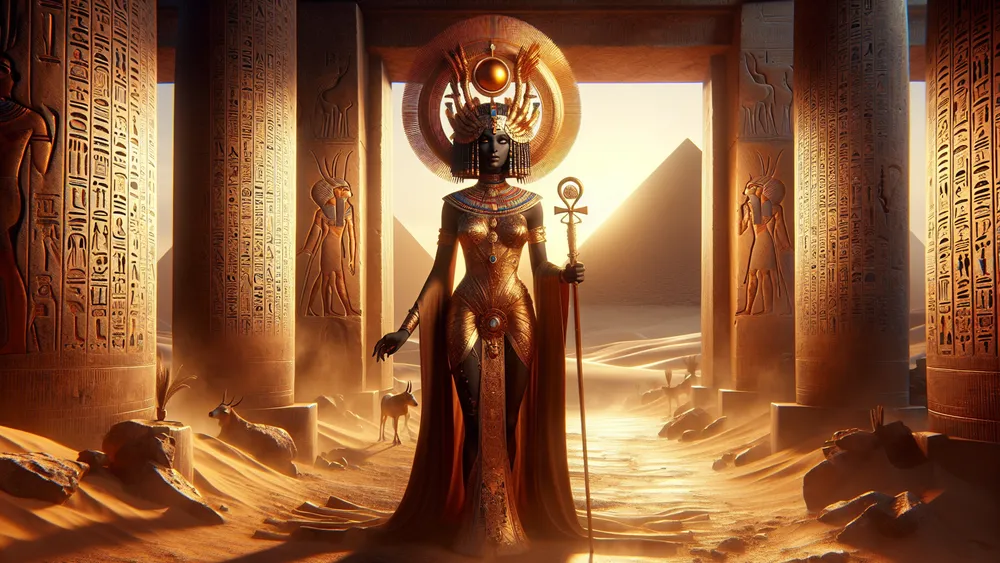
Research and Studies
Latest school research and digging results brought new info about Iusaaset. They show more of her role and importance in old Egyptian religion. It is good to know, the latest digs in Heliopolis found old temple pieces and old items giving more details on how people worshiped her.
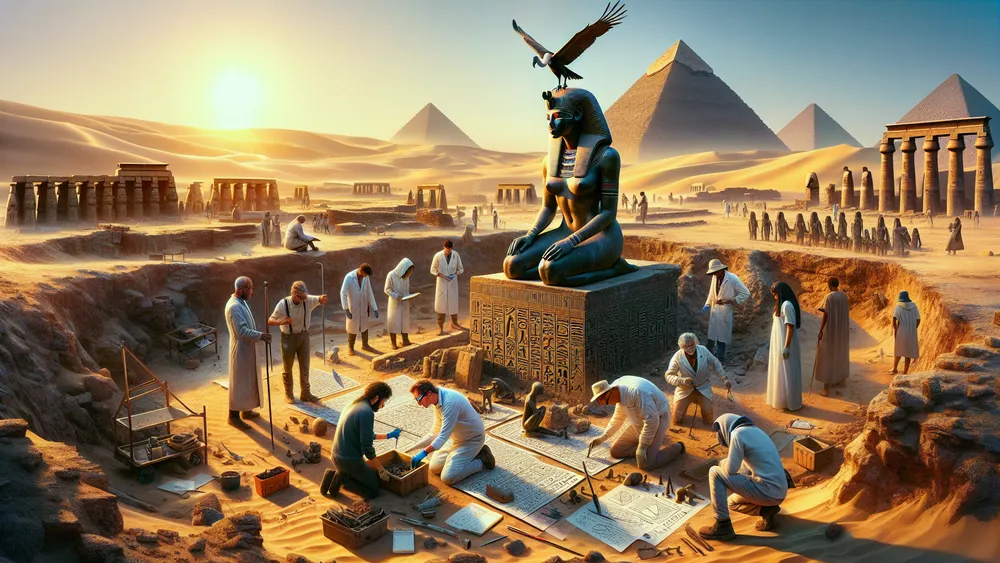
Continuous research, like putting a tough puzzle together, uncovers layers of old Egyptian ideas, helping us see how gods like Iusaaset were respected, also how they mattered in everyday life. These findings, by adding to our knowledge of Iusaaset, give a wider understanding of the complex picture of old Egyptian stories and religion.
Pantheon of Egyptian Gods
The group of Egyptian gods is large and detailed, including a set of gods each with special jobs and traits. If you are interested in looking at everything about these gods, and for a complete look, you can check out this list of all the Egyptian gods. This big list shows how they are linked, much like a big family, each member adding to the rich picture of old Egyptian stories.
FAQs
1. Who is Iusaaset in Egyptian mythology?
Iusaaset in Egyptian mythology is considered the primordial goddess of creation and the shadow of the creator god Atum.
2. What symbols are associated with Iusaaset?
The symbols associated with Iusaaset include the scepter and the ankh, which represent her divine authority and eternal life.
3. How was Iusaaset worshipped in ancient Egypt?
Iusaaset was worshipped in ancient Egypt through rituals, offerings, and festivals dedicated to her in temples.
4. What is the significance of the Tree of Life in relation to Iusaaset?
The significance of the Tree of Life in relation to Iusaaset lies in its representation of creation, growth, and sustenance, which are central to her role as a goddess of creation.

